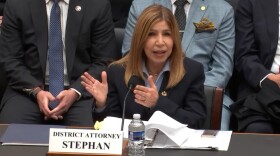About ten years ago, Ana Moreno was a PhD student at UC San Diego when she had a free Sunday night and did what some serious students do. She started reading science papers.
“I came across a paper that talked about these people in Pakistan, street performers, who could walk on fire and do different performances with no pain whatsoever," Moreno said. “And when they studied these people they found they had a mutation in their genome.”
That story was the spark that led Moreno to try to imagine a gene therapy that would relieve chronic pain.
Her personal life also inspired her. She remembers her vivacious aunt, who was also her godmother, when she was growing up in Mexico. Her aunt came down with trigeminal neuralgia, a nerve disorder that causes an intense stabbing pain to the head and face.
“I saw my aunt become — she was the life of the party — and she went from that to someone who was always in pain and there’s no quality of life,” Moreno said.
So Moreno founded a company called Navega Therapeutics, to test and commercialize her patented gene therapy. She said it has shown good results in mice. Human clinical trials are 12 months away.
In this therapy, you inject the shell of a virus into the body that carries a protein that changes gene expression. It turns off a part of the DNA that allows pain impulses to travel along channels that lead to the brain.
“And these sodium channels open and close depending on pain. So when they open it’s like turning on the lights,” Moreno said. “For example when you touch something hot, the ion exchange goes through your arm, through your back to your brain and that’s when you feel the pain. So we can turn it off at the spinal level, depending on where the pain is located.”
Living with chronic pain
Moreno began working on this pain relief model when the opioid addiction crisis started ramping up ten years ago.
Chronic pain and opioid use are also a part of my story.
Almost twenty years ago I was in a serious traffic accident where I suffered a traumatic brain injury. Ever since then I’ve had chronic pain in the lower part of my body. I’ve tried lots of different ways to ease that pain. Acupuncture. Chiropractic. Cannabis. But the only thing that really worked, and it worked every time, was opioid medication.
“First of all I’m sorry to hear of your pain and suffering and, you’re not alone, there are so many people in this country going through this,” said UC San Diego psychiatry professor Eric Garland in response to my story.
“And some people do quite well on the opioids,” Garland said. “And there are other folks who, over time, because of side effects or the natural tolerance that develops to the drug, they find that they are not getting the kind of relief that they want to get.”
Garland is part of the Sanford Institute for Empathy and Compassion at UCSD who focuses on mindfulness and meditation as a way to fight addiction and reduce chronic pain. His description of “other folks” pretty well describes a man who came to him for help.
Dan Kruger is a motorcycle racer who has a high profile in the media and races at the top of his profession. He said he also suffered decades of chronic pain and was addicted to opioids, due to psoriatic arthritis and a career filled with serious injuries he suffered on the race track.

“In the whole span of my adult life and even my teenager life, I’ve broken my leg. I’ve broken both ankles. Broken eight ribs, punctured lungs, two major concussions,” Kruger said, adding to that two broken collarbones and breaks in both of his wrists.
He’s lived in what he describes as a “circle of pain” along with his addiction. But he said the good money he made and the love of his wife and kids allowed him to ignore it for quite a while.
“I really was a quiet addict,” Kruger said. “Because if you look at it from the outside, you’re like, ‘Here’s this guy who’s getting lots of press. His house keeps getting bigger. His cars keep getting nicer. What could possibly be wrong with him?’”
Kruger was scrolling the web one day when he stumbled upon a YouTube video featuring Eric Garland and his brand of treatment. That’s when Kruger reached out and learned to meditate.
Teaching the brain to block chronic pain
The therapy model Garland has tested for 20 years goes by the acronym MORE, standing for Mindfulness Oriented Recovery Enhancement. It’s rooted in meditation and, Garland said, seeks to give people the skills of self awareness and self control.
He said people who are dependent on opioids must relearn how to savor things in life that make us happy. He refers to a study about MORE therapy, just published in the Journal of the American Medication Association (JAMA)
“In this study we showed that people with opioid use disorder have a difficulty savoring natural healthy pleasure. They just struggle to try to feel good naturally and that has to do with the impact of chronic, long-term opioid use on the brain,” Garland said.
He said that the study in JAMA shows that mindfulness therapy is proven to be effective in blocking pain and lessening opioid use.
“So we’ve done large clinical studies in people with chronic pain who are prescribed opioids and we have shown that the MORE therapy reduced opioid misuse by 45% at a nine-month follow-up point,” he said.
“We’ve also shown that 50% of people treated with MORE show a clinically significant reduction in pain.”
Garland worked with Kruger, who said three years since his introduction to the therapy. things are much better.
“My chronic pain is 20%, 25% less than it was while I was on opioids. So my chronic pain is lower,” he said. “I have it. I have it right now as I speak to you. But it is absolutely manageable.”
Health professionals estimate between 20% and 25% of people who are prescribed opioids end up with opioid use disorders, which include full-blown addiction.
There are pain management alternatives. But even if they are going to work for you Garland said it doesn’t mean you’ll have access to them or that your health insurance is gonna cover them.
Some patients still believe opioid medication is the greatest source of relief from their pain and they can be taken with minimal side effects.
Some of them have formed a lobbying group called Don’t Punish Pain to oppose any new restrictions on opiate use.





